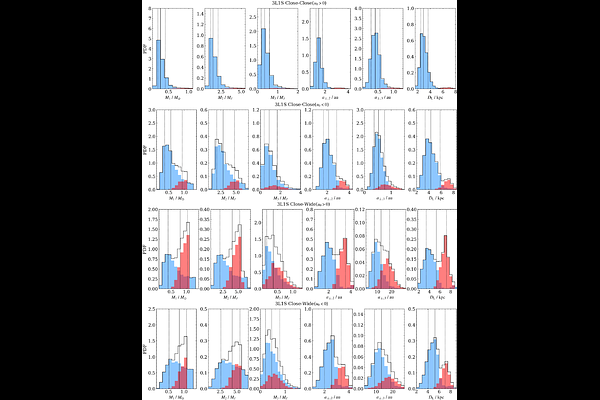KMT-2022-BLG-1818Lb,c: A Cold Super-Jupiter with a Saturn Sibling

KMT-2022-BLG-1818Lb,c: A Cold Super-Jupiter with a Saturn Sibling
Hongyu Li, Jiyuan Zhang, Cheongho Han, Weicheng Zang, Youn Kil Jung, Andrzej Udalski, Takahiro Sumi, Hongjing Yang, Renkun Kuang, Shude Mao, Michael D. Albrow, Sun-Ju Chung, Andrew Gould, Kyu-Ha Hwang, Yoon-Hyun Ryu, In-Gu Shin, Yossi Shvartzvald, Jennifer C. Yee, Sang-Mok Cha, Dong-Jin Kim, Seung-Lee Kim, Chung-Uk Lee, Dong-Joo Lee, Yongseok Lee, Byeong-Gon Park, Richard W. Pogge, Berto Monard, Yunyi Tang, Subo Dong, Zhuokai Liu, Grant Christie, Jennie McCormick, Tim Natusch, Qiyue Qian, Dan Maoz, Wei Zhu, Przemek Mróz, Michał K. Szymański, Jan Skowron, Radoslaw Poleski, Igor Soszyński, Paweł Pietrukowicz, Szymon Kozłowski, Krzysztof A. Rybicki, Patryk Iwanek, Krzysztof Ulaczyk, Marcin Wrona, Mariusz Gromadzki, Mateusz J. Mróz, Michał Jaroszyński, Fumio Abe, Ken Bando, David P. Bennett, Aparna Bhattacharya, Ian A. Bond, Akihiko Fukui, Ryusei Hamada, Shunya Hamada, Naoto Hamasak, Yuki Hirao, Stela Ishitani Silva, Naoki Koshimoto, Yutaka Matsubara, Shota Miyazaki, Yasushi Muraki, Tutumi Nagai, Kansuke Nunota, Greg Olmschenk, Clément Ranc, Nicholas J. Rattenbury, Yuki Satoh, Daisuke Suzuki, Sean Terry, Paul J. Tristram, Aikaterini Vandorou, Hibiki Yama
AbstractWe present the discovery and analysis of the sixth microlensing two-planet system, KMT-2022-BLG-1818Lb,c, detected by a follow-up program targeting high-magnification events. Both planets are subject to the well-known ''Close/Wide'' degeneracy, although for the first planet, which has a super-Jovian mass ratio of $q_2 \simeq 5\times 10^{-3}$ in both solutions, the Close topology, with a normalized separation of $s\simeq 0.70$, is clearly preferred by $\Delta\chi^2=26$. However, contrary to all previous two-planet microlensing systems, the mass ratio for the second planet, $q_3$, is substantially (factor of $\sim 10$) different for the Close and Wide topologies of the first planet. While this degeneracy is resolved in the present case due to high-cadence follow-up observations, the appearance of this new degeneracy indicates the need for caution in the analysis of future two-planet systems. A Bayesian analysis suggests that the host is likely a K-dwarf star in the Galactic disk. The first planet is probably a super-Jupiter on a Jupiter-like orbit, while the second planet is a Saturn-class planet on either a Mercury-like or Saturn-like orbit.